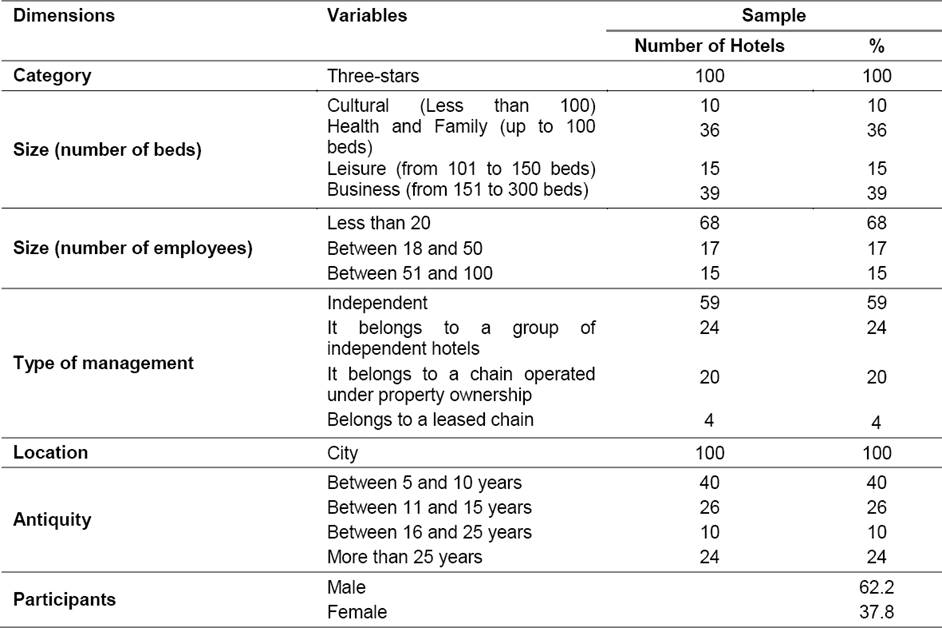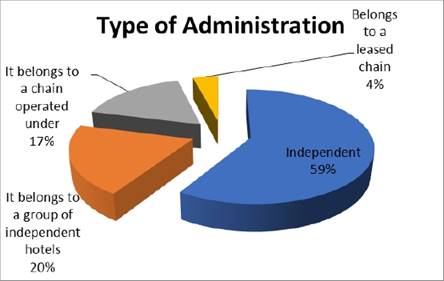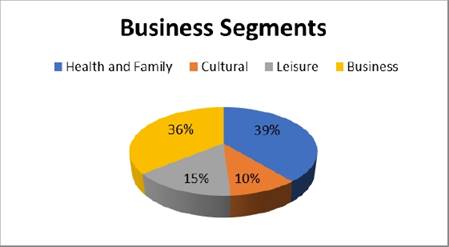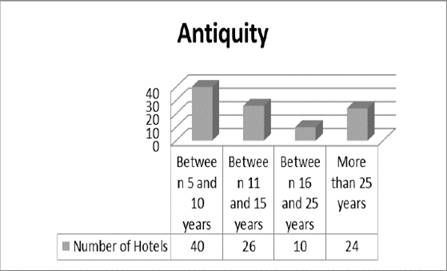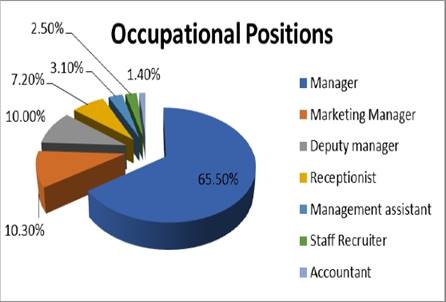1 Introduction
One of the key developments in marketing has been the advent of customer relationship management strategies, designed primarily to create and manage long lasting customer relationships. In today’s age where firms are facing a radically different landscape, the process of relationship building between a company and its customers enhances lifetime value and increases profitability [16]. In this context, the marketing relational is not only an instrument but a strategy for effective customer relationship management and a measurement for attitudes and intentions of customer retention and customer profitability in a competitive market.
Hotels are at the front end of the services industry sector and consequently are the “interface” from which consumers make their service requests. This suggests that the hotels industry sector is likely to be ahead of other industries in understanding of customer relationship management. We know that most the top hotels have websites and is evident that advances in technology will continue to be a critical element in customer relationship management. Considering the issue of information systems (IS) and relationships, the literature is almost silent on customer satisfaction, during and after services [12]. Essentially, this research responds to a call for a new thinking where customer relationship failure rate, customer retention and profitability are not properly addressed. Some hotels showed little interest to the survey that wanted to know how much improvement has been experienced due to customer relationship management performance.
In this investigation, regarding the content of the blocks that form the questionnaire, in the first of them we include the definition proposed for the handling of the relations with the clients and we asked the hotels if they were carrying out initiatives of this type, their temporary duration and what was the responsible department. In the case of not implementing any such strategy, we include several probable causes and that we specify in the following opinions: excessive cost, not considered necessary, lack of solutions and advantages that offer, no budget, plan to implement it in a future and other causes.
We also included some questions about tools and channels used to manage the relationship with clients, to increase our knowledge on the subject.
The following five blocks of the questionnaire refer to four relevant systems that are part of the customer relations model, resulting from this research work (oriented towards the organization of a viable, technology oriented, customer oriented and Knowledge) and is being validated with the tool implemented for that purpose. We have items to measure the questionnaire that come in the scale constructed for the model.
To measure the relevant systems, managers or managers of three-star hotels were asked to rate on a Likert 7-point scale (from 1: strongly disagree to 7: strongly agree), the degree of agreement with each of the questions contained in the table of items of the model.
Finally, the last block of the questionnaire contains general data about the hotel establishment: category, type of management, age of establishment, segment in which it is fitted, size, location, profile of the respondent. The category was measured in stars, based on the new hotel classification in Mexico, published in September 2016 in the Official Gazette of the Federation [5].and it is the application of this questionnaire and the analysis of results that are shown in this article.
2 Customer Relationship Management and Hotelier Sector
Gronroos [6] says that service organizations for their intrinsic characteristics of the production and consumption are inseparable elements necessary to build relationships with customers.
Accordingly, customer relationship management will be ideally suited to the hotel industry, especially when implementing it successfully and effectively, taking into our account that hotels receive a lot of data about customers. Such data can be transformed into useful knowledge about them [11].
Also, it goes without saying that growing customer- acquisition costs, rising customer expectations, price-sensitive travelers, more sophisticated clients, uncertain market and less brand loyalty are all key factors, which strongly urge hotels to focus on customer relationship management strategies as a useful strategy. Customer relationship management strategy is widely considered as one of the most effective ways to facilitate developing and expanding the customers' base that, in turn, will assist in enhancing profitability and guest loyalty [15].
3 Observer Population
The INEGI [8] has information gathered from the censuses of SMEs of the various sectors and considers that the services of hotels and restaurants are the ones that make the highest contribution to added value.
The INEGI provides, through the Tourist Offices of the States, information on the offer of accommodation in the entities of the country, broken down by rooms and by establishments. This information is updated in July of each year and the corresponding information is uploaded at the close of the previous year.
The latest results provided on the Accommodation Offer in Mexico are a total of 20,038 establishments with a total of 736,512 rooms by July 2015, for all the states of the Republic. This information is reviewed annually by each of the State Tourism Offices and is provided by the Tourism Offices of the Governments of the States and Mexico City (CDMX). State Tourist Information System (SITE) - SECTUR. National Fund for Tourism Promotion (FONATUR). Hotels Association of Quintana Roo A.C.
For data collection, a questionnaire was developed and sent via email. The study population included 141 three-star hotels collected by the [22] according to the new hotel classification [5]. Once the email addresses were entered on the survey platform 2 were detected as erroneous, so the survey was finally sent to 139 hotels, which was established as the definitive population. Field work was carried out between October and December 2016 (from October 15 to December 31), the description of the hotels that make up the sample are observed in Table 1.
Table 2 reports that 68% (n=68) of the respondents were from hotels that employed less than 20 workers each, while 17% (n=17) of the respondents indicated hotels that had a workforce between 18-50 employees and a 15% (n=15) reported between 51-100 employees. Regarding the gender of the participants, 62.2% were male respondents while the remainders 37.8% were female. The study also reports most of the participants (78.3%) as being married.
On the other hand, once we have commented the various characteristics of the three stars’ hotels that make up the sample, we will proceed to make a descriptive analysis of the different variables examined. Firstly, about the degree of implementation of the customer relationship management model (loyalty and customer retention programs) in hotels analyzed at 50.8% (50.8 ≅ 51 hotels), they succeeded in implementing the strategy successfully.
This is because one of the variables considered in the evaluation for the hotel classification and that scores, is attention to complaints and loyalty programs, reason why, hotel establishments are more interested in the type of strategies oriented to the customer satisfaction.
Instead, for this study it was important to consider the hotels that already knew a strategy of handling the relations with the clients and to know what time they were using it and which department was responsible.
That most of the hotels surveyed (50.3%) had carried out this strategic initiative for more than two years, so it is possible to affirm that the hotels that make up the sample had a certain degree of experience and maturity in the use relational marketing.
Then, hotels that stated that they were not carrying out customer relationship management initiatives (49.2% of the sample) were asked about the causes; Of which, the most cited was the lack of solutions and advantages offered (30% of the cases), nevertheless, 19.2% said to be planning its implementation in the future.
Therefore, although we still find a certain lack of relational marketing in non-user hotels, we also observed how many of them were already considering their implementation, which is why the use of the relationship model with Clients in this research, which can be affirmed that in the coming years the percentage of implementation of this type of strategies in hotels that can be considered SMEs (Small and Medium Enterprises) in Mexico, will be significantly increased.
Also focusing on the main channels of contact with customers, we observed that the most used by the hotels surveyed were email (31%), telephone (25.7%) and website (19.2%). This high use of e-mail shows that the hotel sector does indeed show a higher than average use of the Internet in other sectors.
3.1 Data Collection and Study Data Sheet
The sampling method used was a probabilistic sampling, in which each element of the study population has a known probability of being part of the sample [15].
Specifically, the type of sampling was the simple random, since a complete list of the individuals that composed the population (hotels of 3 stars collected by the SECTUR [22] - Government of the City of Mexico) was available, and all of them were he sent them the questionnaire.
For the collection of data, we developed a web questionnaire, "Survey Monkey" for the design and administration of the same. The population under study included the 141 three-star hotels collected by the SECTUR [22] based on the new hotel classification [5].
Once their e-mail addresses were entered on the survey platform 2 erroneous e-mail addresses were detected, so the survey was finally sent to 139 hotels, which was set as the definitive population. Fieldwork was carried out between October and December 2016 (from October 15 to December 31).
As several authors [7] comment that the response rate using a web questionnaire is often increased when reminders are made, to improve the study response rate two reminders of the questionnaire were sent to the different hotels surveyed. Finally, 100 completed questionnaires were obtained, so the response rate was 70.92%, which is a very high percentage.
Table 1 shows the technical data of the field study. Where it’s shown that the sampling error amounted to 6.5% (0.065).
The calculation of this error was made using the formula:
considering p = q = 0.5 and with a confidence level of 98.6%,
where:
− n: is the sample size that we want to determine or know,
− z: represents the degree of confidence that we are going to put in obtaining safe or adequate results in the procedure of determining a sample size that is representative. It’s a critical value, calculated in the tables of the area of the Normal curve,
− e: estimation error,
− p: probability in favor,
− q: probability against.
4 Detailed Analysis
Based on the data collected in Table 1 it is possible to observe that most of the hotels that made up the sample (39%) were family type, since they had less than 100 beds. It can also be noted that there is a high percentage of hotel SMEs that, based on accommodation capacity, can be considered as medium (15%) and large (36%). Likewise, if the size or capacity of customer service is measured, considering the number of employees, most of the hotels that made up the sample (68%) had fewer than 50 employees.
On the other hand, to examine the different management modalities of the hotels analyzed based on the categories proposed by Claver et. Al [4]: independent hotels, operated under property ownership and leasing. The graphical representation of the different management modalities of the analyzed sample can be observed in Figure 1. It shows how 59% of the sample hotels were managed independently and 20% belonged to a group of independent hotels.
Regarding the business segments in which the hotels analyzed are based on customer demand (see Figure 2), they are Health and Family (39%), Cultural (10%), Leisure (15%) and Business 36%). Mexico is a country that attracts people because of its diversity in tourist places and gastronomy; in addition, Mexico City is visited every day by people who come on business trips, which is why it is possible to observe how this segment of the Show a greater frequency, as well as hotels located in areas accessible to tourists, which reflects that, indeed, city tourism and business are significant to the country.
The trend of hotel SMEs in Mexico highlights that the four segments show a high potential for development, with business tourism showing the greatest growth prospects in the coming years. On the other hand, as emerging segments highlights the importance of cultural tourism and leisure.
Also, if seniority is examined (see Figure 3), considered as years of operation of the SMEs surveyed, it is shown as a high percentage mentioned being recently opened, with less than 10 years in operation (40%). This situation is possible due to the important increase of the hotel supply that is taking place in Mexico in recent years.
To conclude the study of the profile of the sample, it should be noted that 62.2% of the respondents were men and 37.8% were women, occupying distinct positions within the hotel SME; Although the questionnaire was intended to be applied to the hotel manager, but because the responsibility of the customer relationship management lies in the various areas that are established and delimited in the organization, it is considered important to examine the profile of those who finally answered the survey.
Figure 4 shows the profile and shows that the managerial position of the hotel SME is the one with the highest percentage (65.5%), followed by the marketing manager, when they had that role (10.3%).
Other positions mentioned are sub-manager, head of reception or receptionist and assistant manager, recruiter staff and accountant.
Because the questionnaire was answered by personnel located at the top of the hierarchical structure, the resulting information is considered valid and reliable and provides a timely picture of the customer relationship management situation in the three-star hotel SMEs in Mexico City.
5 Contrast Hypotheses
5.1 Hypotheses
In this conceptualized model implantation is the predictor while customer profitability is the outcome as mediated by customer loyalty and customer retention. Considering this view and drawing from literature, the customer relationship management implementation and implantation, is expected to impact positively on customer loyalty and customer retention capacity for hoteliers three-stars in Mexico.
These mediating variables are expected to positively impact on customer profitability [10]. The relationships have also been supported in prior empirical studies that focused their investigations on SMEs in general [3]. Consequently, based on the illustrated relationships, the current study projects four hypotheses as follows:
− Hypothesis 1: Customer relationship management depends on the performance of SME Hotels And impacts on customer loyalty.
− Hypothesis 2: Adequate technology management will have a positive impact on the results of customer relationship management implementation.
− Hypothesis 3: Adequate customer orientation will have a positive impact on the results of customer relationship management implementation.
− Hypothesis 4: Adequate knowledge management will have a positive impact on the results of customer relationship management implementation.
5.2 Hypotheses Testing
The relevant system result from the implementation of customer relationship management model was measured using a 7-item scale, which evaluates the consequences from both a financial (profitability) and market (loyalty-trust, customer satisfaction- retention).
In this case, the items with the highest average scores indicated that customer relationship management had improved the level of customer trust (loyalty), satisfaction, and loyalty level respectively. Therefore, the hypotheses raised in section 4.1 of this article, for hotels that could implement and properly implement the customer relations strategy, were accepted.
It may be concluded the following:
(1) The implementation model of customer relationship management within three-star hotels has a positive impact on the loyalty of its clients and depending on the performance of SMEs (Hypothesis 1), and adequate management of technology Will have a positive impact on the results, impacting on its ability to retain clients (Hypothesis 2).
(2) Adequate customer orientation will have a positive effect on the results of the implementation of customer relations management, ensuring customer loyalty to hotels with a direct positive impact on the profitability of hotel clients (Hypothesis 3) and Customer retention of clients (customer retention capacity) has a direct positive impact on customer profitability due to adequate knowledge management, positively affecting the results of the implementation of customer relationship management ( Hypothesis 4).
6 Conclusions
Regarding the study carried out through the questionnaire, it was planned to examine the degree of development and implementation of customer relations management in the Mexican hotel sector, particularly for three-star hotel SMEs, based on the new hotel classification in Mexico, as well as to carry out a validation of a systemic model for the implementation of the management of customer relations. For this, the study focused on examining a sample of 100 Mexican SME 3-star hotels.
The sample obtained was representative of the population, with a confidence interval of 98.6% and a sample error of 6.5%. Firstly, about the implementation of customer relationship management strategies, we observed that 50.8% of the hotels surveyed stated that they are carrying out such a strategy, which shows that there is interest in their implementation in the hotel sector.
Among hotels that were not carrying out customer relationship management initiatives, 19.2% planned their future implementation, which shows the potential for growth of this type of strategies in the hotel sector in coming periods and a field of Application for systemic models of customer relations management. It is considered that the publication of the New Hotel Classification that punctuates the use of strategies of this type in its questionnaire for the classification of star hotels, influences the interest of companies in implementing the management of relations with customers.
This study sought to examine the results of implementation and implementation of the customer relationship management model proposed as part of a larger project, which is the basis of this survey, and its impact on customer loyalty and customer retention within hotels in Mexico and the resulting effect on profitability. Market pressure for Mexican hotel SMEs can contribute to the adoption of customer relationship management [18].
The present study postulated four hypotheses and tested them, we collected data from employees of three-stars hotels in Mexico. The empirical results supported all the hypotheses of investigation postulated in a significant way.
The findings also confirm the importance of customer relationship management in the services industry sector and the contemporary business operations, with prevalent developments in electronic services integration growing in the sector. In a nutshell, this study submits that the hoteliers and their managers can successfully improve their customer profitability and business performance by exploiting their relationship management strategies through restructuring operations and implementing of customer relationship management. Eventually, a successful customer relationship management model is expected to boost customer loyalty, retain profitable customers and generate more revenue for the hotels, hence their overall performance and survival.
What should be made clear is that customer relationship management is more than a software tool for sales; customer relationship management is a business strategy that seeks customer satisfaction to achieve retention and loyalty [19].











 text new page (beta)
text new page (beta)

